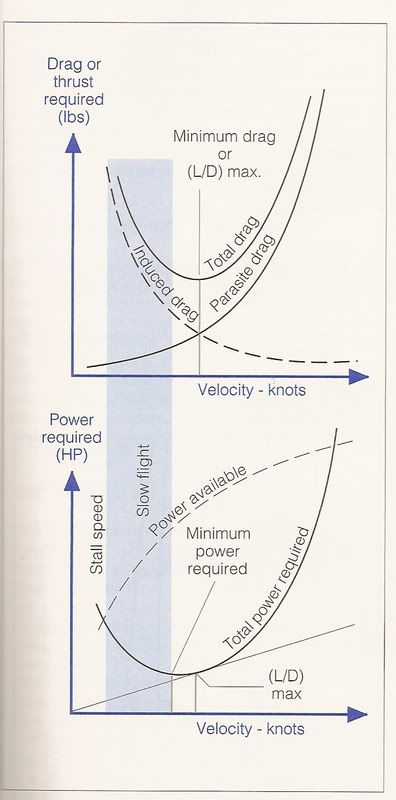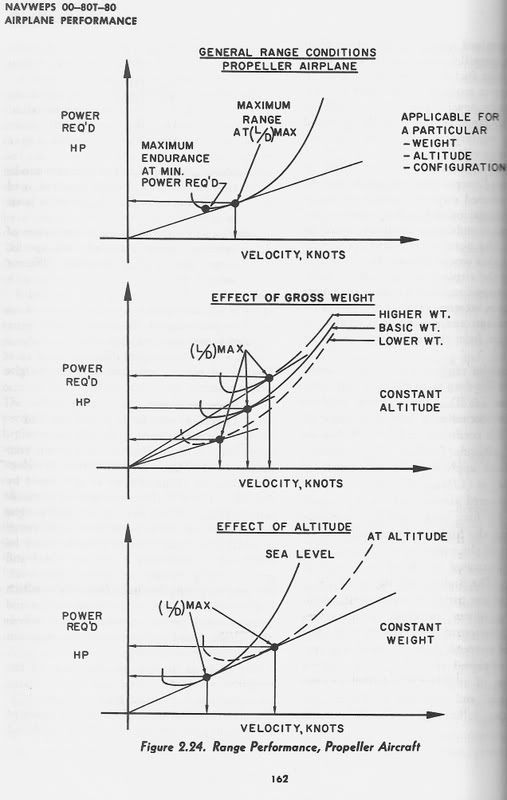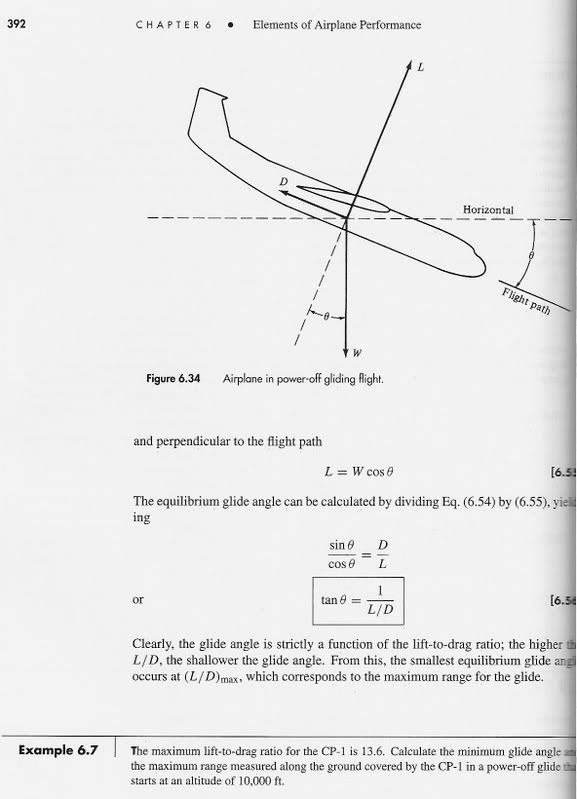Range vs Glide in a cherokee
Moderators: North Shore, sky's the limit, sepia, Sulako, Right Seat Captain, lilfssister
Range vs Glide in a cherokee
If Best Glide is set at 69 knots. Then why is Max Range not also set at 69 knots (sense both are supposedly flown at max L/D ratio)? Why does the speed vary for max range?
Also->Ignoring the POH, is it possible to determine max range using the experimental method while in the air?
Also->Ignoring the POH, is it possible to determine max range using the experimental method while in the air?
-
mellow_pilot
- Rank 10

- Posts: 2119
- Joined: Wed Aug 17, 2005 1:04 am
- Location: Pilot Purgatory
Granted it's early, and I'm sick as beans... but isn't it the other way round?
Max L/D = max distance foward per unit altitude loss
Max endurance/Min sink = least altitude loss per unit time
(that's all assuming no engine power)
Am I mixed up here?
Max L/D = max distance foward per unit altitude loss
Max endurance/Min sink = least altitude loss per unit time
(that's all assuming no engine power)
Am I mixed up here?
Dyslexics of the world... UNTIE!
-
mellow_pilot
- Rank 10

- Posts: 2119
- Joined: Wed Aug 17, 2005 1:04 am
- Location: Pilot Purgatory
I'm gonna have to call this one...
Fan, you really had me doubting myself there for a min. You were so sure of yourself! (I'm really not trying to be insulting here, just want to make sure the proper info gets out.)
(I'm really not trying to be insulting here, just want to make sure the proper info gets out.)
I checked the FTM, and a couple texts...
Range is flown at max L/D. Endurance is flown at min power req. If it gets confusing, take it back to gliding flight. Max L/D gives you the most air distance per unit altitude loss.
To answer McFly's questions;
They are probably different because they are calculated at different weights, or they have taken into account the propeller slip under power and/or windmilling during glide. There are a host of other reasons why they may be different, perhaps they have padded the glide speed to ensure that you don't stall. Range changes with weight. Most light aircraft POHs only have numbers calculated for max gross, maybe a few others.
As for methods to be used in the air; the FTM doesn't mention it, but you can do range the same way you do endurance, only watch for the drop in airspeed. The drop should be consistent til you get below L/D max, then a larger drop will occur. (IIRC, instructors don't hesitate to jump in here)
Either way, you can be assured that L/Dmax is used for range. Min sink/endurance is a lower speed.
(incase you're not convinced, I'm including some pretty pictures.)
From the FTM:

From Aerodymanics for Naval Aviators (The US Navy's own FTGU):

From Introduction to Flight (an Aeronautical Engineering textbook):

Fan, you really had me doubting myself there for a min. You were so sure of yourself!
I checked the FTM, and a couple texts...
Range is flown at max L/D. Endurance is flown at min power req. If it gets confusing, take it back to gliding flight. Max L/D gives you the most air distance per unit altitude loss.
To answer McFly's questions;
They are probably different because they are calculated at different weights, or they have taken into account the propeller slip under power and/or windmilling during glide. There are a host of other reasons why they may be different, perhaps they have padded the glide speed to ensure that you don't stall. Range changes with weight. Most light aircraft POHs only have numbers calculated for max gross, maybe a few others.
As for methods to be used in the air; the FTM doesn't mention it, but you can do range the same way you do endurance, only watch for the drop in airspeed. The drop should be consistent til you get below L/D max, then a larger drop will occur. (IIRC, instructors don't hesitate to jump in here)
Either way, you can be assured that L/Dmax is used for range. Min sink/endurance is a lower speed.
(incase you're not convinced, I'm including some pretty pictures.)
From the FTM:

From Aerodymanics for Naval Aviators (The US Navy's own FTGU):

From Introduction to Flight (an Aeronautical Engineering textbook):

Dyslexics of the world... UNTIE!
-
mellow_pilot
- Rank 10

- Posts: 2119
- Joined: Wed Aug 17, 2005 1:04 am
- Location: Pilot Purgatory
No worries Fan, I figured you might be thinking jet, but then the question was about cherokees.
mcfly, there are quite alot of good books out there, if you're intrested in learning more than just the basics, get a first year aeronautical engineering book.
mcfly, there are quite alot of good books out there, if you're intrested in learning more than just the basics, get a first year aeronautical engineering book.
Dyslexics of the world... UNTIE!
Just a note:
The CP-1 in the above reference from "Introduction to flight" is a C-182,
To answer the question from the get go.
The reason being the prop is windmilling when you are gliding, this adds ALOT of parasite drag, and without getting into all the math, changes the speed of best L/D.
The CP-1 in the above reference from "Introduction to flight" is a C-182,
To answer the question from the get go.
The reason being the prop is windmilling when you are gliding, this adds ALOT of parasite drag, and without getting into all the math, changes the speed of best L/D.
-
mellow_pilot
- Rank 10

- Posts: 2119
- Joined: Wed Aug 17, 2005 1:04 am
- Location: Pilot Purgatory
Your local university library or uni bookstore could help. Perhaps Amazon.ca or similar. John D. Anderson is a pretty good author, although you may have to skip over some of the calculus if you're not up to speed. No worries though, he explains things well without math too.
Where are you?
Where are you?
Dyslexics of the world... UNTIE!
Well thats not a very simple question to answer,mcfly wrote:where do i find such a first year aeronautical engineering book ?
I would like to check it out. There's alot of weakly explained stuff in my FTGU books.
The above mentioned text is a bit beyond the "first year" engineering level, and far beyond the average pilot. That being said, there might be some other text that would be more suited to your needs. I'll keep the feelers out.
Most of whats writen in from the ground up and other aviation publications are about as technical as the average person can absorb. When you try and explain something, to a person that doesnt have the background to uderstand it, your just wasting your time. (for example the "stall" in an airplane and the general public)
If you really want the text noted above you shouldnt have much trouble finding it.
"Introduction to flight by Anderson".
If you have any other questions, drop me a line.


